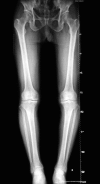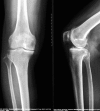Surgical Technique of Total Knee Arthroplasty without Soft Tissue Balance
- PMID: 28032705
- PMCID: PMC6584677
- DOI: 10.1111/os.12289
Surgical Technique of Total Knee Arthroplasty without Soft Tissue Balance
Abstract
Total knee arthroplasty (TKA) without soft tissue balance can create a balanced knee to a mechanical axis of near neutral with bone cuts, and remove osteophytes thoroughly. In this study, the authors present detailed steps for performing TKA. The attached video demonstrates the TKA procedure. The patient is a 77-year-old man who had suffered from knee pain for 12 years. Physical examination showed the Apley test to be positive and that the range of motion (ROM) decreased. An X-ray filmed at the positive lateral of the knee joint and the double lower extremity revealed a progression of degenerative osteoarthritis with genu varum. The key point of no soft tissue release is to make a rectangular extensional space by osteotomy. In addition, the osteophytes, especially syndesmophytes, should be removed thoroughly. As a result, the ligaments can achieve ideal length and the flexion contracture can also be remedied. Moreover, in surgeries without soft tissue release, bone mass and normal tissue are retained. Patients are satisfied to the surgery not only with less blood loss, anterior knee pain and DVT, but also faster rehabilitation. In summary, TKA without soft tissue balance is an efficient procedure for patients with knee osteoarthritis which can result in good prognosis.
Keywords: Osteophytes; Rectangular osteotomy; Soft tissue balance; Total knee arthroplasty.
© 2016 Chinese Orthopaedic Association and John Wiley & Sons Australia, Ltd.
Figures
Similar articles
-
Comparison of Intraoperative Soft Tissue Balance Between Cruciate-Retaining and Posterior-Stabilized Total Knee Arthroplasty Performed by a Newly Developed Medial Preserving Gap Technique.J Arthroplasty. 2018 Mar;33(3):729-734. doi: 10.1016/j.arth.2017.09.070. Epub 2017 Oct 12. J Arthroplasty. 2018. PMID: 29103777
-
Effect of Posterior Osteophytes on Total Knee Arthroplasty Coronal Soft Tissue Balance: Do They Matter?J Arthroplasty. 2022 Jun;37(6S):S226-S230. doi: 10.1016/j.arth.2022.01.034. Epub 2022 Feb 23. J Arthroplasty. 2022. PMID: 35216852
-
[Balancing of soft tissues in total knee arthroplasty for patients with rheumatoid arthritis with knee flexion contracture].Zhongguo Xiu Fu Chong Jian Wai Ke Za Zhi. 2008 Oct;22(10):1173-6. Zhongguo Xiu Fu Chong Jian Wai Ke Za Zhi. 2008. PMID: 18979871 Chinese.
-
[Development of the technique for measuring soft tissue balance in knee replacement].Sheng Wu Yi Xue Gong Cheng Xue Za Zhi. 2007 Aug;24(4):937-40. Sheng Wu Yi Xue Gong Cheng Xue Za Zhi. 2007. PMID: 17899778 Review. Chinese.
-
Different surgical options for monocompartmental osteoarthritis of the knee: high tibial osteotomy versus unicompartmental knee arthroplasty versus total knee arthroplasty: indications, techniques, results, and controversies.Instr Course Lect. 2004;53:265-83. Instr Course Lect. 2004. PMID: 15116621 Review.
Cited by
-
Valgus Correctability and Meniscal Extrusion Were Associated With Alignment After Unicompartmental Knee Arthroplasty.Clin Orthop Relat Res. 2020 Jul;478(7):1636-1644. doi: 10.1097/CORR.0000000000001260. Clin Orthop Relat Res. 2020. PMID: 32324667 Free PMC article.
-
Preoperative valgus-corrected hip-knee-ankle angle and medial meniscal extrusion are useful for evaluating postoperative alignment in mobile-bearing UKA.Heliyon. 2023 Nov 17;9(11):e22234. doi: 10.1016/j.heliyon.2023.e22234. eCollection 2023 Nov. Heliyon. 2023. PMID: 38058632 Free PMC article.
References
-
- Prime MS, Palmer J, Khan WS. The national joint registry of England and Wales. Orthopedics, 2011, 34: 107–110. - PubMed
-
- Koh IJ, Kwak DS, Kim TK, Park IJ, In Y. How effective is multiple needle puncturing for medial soft tissue balancing during total knee arthroplasty? A cadaveric study. J Arthroplasty, 2014, 29: 2478–2483. - PubMed
-
- Ranawat AS, Ranawat CS, Elkus M, Rasquinha VJ, Rossi R, Babhulkar S. Total knee arthroplasty for severe valgus deformity. J Bone Joint Surg Am, 2005, 86: 2671–2676. - PubMed
-
- Freeman MA, Todd RC, Bamert P, Day WH. ICLH arthroplasty of the knee: 1968‐‐1977. J Bone Joint Surg Br, 1978, 60: 339–344. - PubMed
Publication types
MeSH terms
LinkOut - more resources
Full Text Sources
Other Literature Sources
Medical
Research Materials



